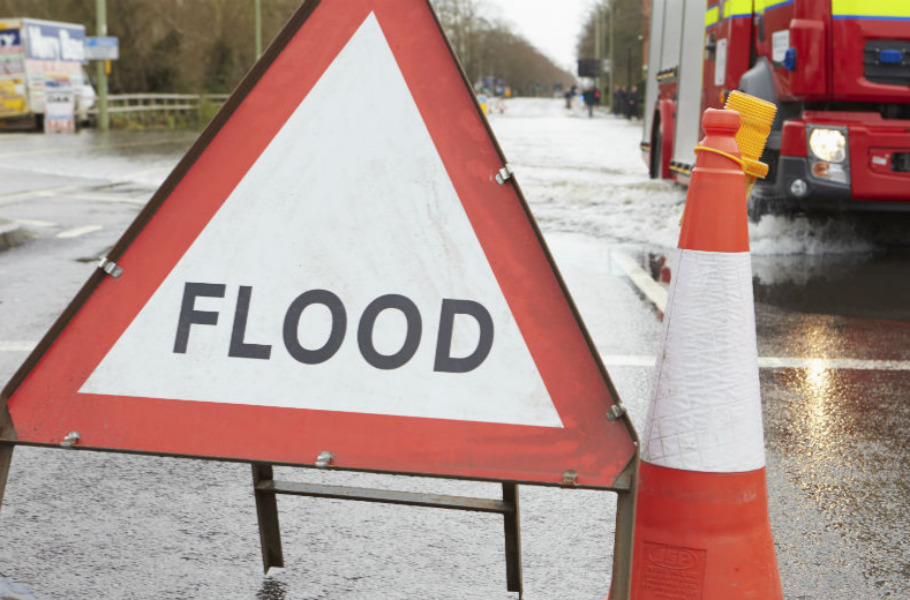Flood Risk Management Guide.

The UK Government has said that “climate change is the greatest environmental challenge facing the world today. Rising global temperatures will bring changes in weather patterns, rising sea levels and increased frequency and intensity of extreme weather events”.
For the UK, “climate change means warmer temperatures, more violent storms, wetter winters and drier summers, plus higher sea levels, leading to flooding of coastal areas”.
What Are The Implications For The Flood Risk To Businesses?
So how has this manifested itself, so far? Compared with 50 years ago the UK now gets more precipitation (rain and snow falls) in terms of quantity, but on fewer days. Falls therefore are less frequent but heavier when they happen. Accurate predictions are hard to make but the Environment Agency has said that the incidence of serious flooding which used to be expected about once in every 100 years may (with climate change over time) occur more often, perhaps every 10/20 years.
After adjusting for natural land movements, the average sea level around the UK is now about 10cm higher than it was in 1900 and this rise is expected to continue. However it is not uniform around the UK. The South of England is very gradually sinking, with consequences for the risk of flooding. It has been estimated that around 175,000 businesses are, at present, located on floodplains.
With rising tide levels and severe weather events becoming more common, many UK businesses are likely to find themselves increasingly exposed to the risk of flooding. The fact of not having suffered a flood in the past can no longer provide the reassurance that it once did.
Applying A Risk Management Approach To The Flood Risk
Although we can’t control the weather or sinking land levels, applying good risk management principles to the risk of flooding is worthwhile. The more at risk your business is, the more important it is for you to take steps to try to manage that risk.
The Environment Agency estimates that businesses that take effective action in response to a flood warning, at least eight hours in advance of a flood, can make up to 90% savings on damage to moveable equipment or stock (i.e. up to 20%–70% for pubs/hotels, 70%–90% hi-tech offices, and up to 50% in retail outlets). To achieve this, effective planning and preparations are needed. You can’t afford to rely on last minute ad hoc measures.
It wouldn’t be possible, in this leaflet, to cover everything that you need to know and consider. Instead we have tried to provide an overview of a risk managed approach and at the same time included some tips that we hope you will find useful. At the end of the leaflet you will find a list of websites where you can find further useful information.
Is There A Significant Risk Of My Premises Being Flooded?
Usually when we talk about a flood we are thinking about an inundation of water from a river or the sea. However, torrential rain can often overwhelm drains and roof gutters, so much of the published advice on how to deal with flooding is also useful when considering the risk from surface rainwater from severe storm etc.
The Environment Agency (EA) publishes online maps which give an indication of the possible floodplains and the likelihood of flooding within those areas(in Scotland see also the Scottish Environment Protection Agency website and in Wales the Natural Resources Wales (NRW) website). You will note from these the EA’s reminder that flood defences are useful but, depending on its type and the severity of the event, can fail.
Putting The Risk Into Context
The EA pages of the www.gov.uk website are a useful place to start. However, you should try to get historical information as well e.g. from the town library or local newspaper archive (or its website). Unfortunately the EA maps will not put your particular premises into context, for example, it may be located in a dip, at the top or bottom of a slope, or in an elevated position, etc. You may have stock in an open yard or compound that is at greater risk than the buildings themselves, or conversely be located on the 10th floor of an office block!
Don’t forget that the absence of a flood in the past, is not now too useful as an indicator of risk. However, a history of flooding (or previous flood warnings) and topography are.
Planning To Cope With A Flood
Having decided that there is a risk of flooding you should start to plan for this unwanted event. From your investigations you should have established to what depth it is predicted flood waters might reach. This, together with the nature of your buildings and the likely effect on your business, will influence the decisions that you take and the plans you make. You will want to make sure that your proposals are appropriate, cost-effective but also adequate to meet the level of risk.
If flood warnings are available in your area, make sure that you have arranged to receive them, so that you can set into motion the emergency actions that you have planned (appropriate to the flood warning level received) at the earliest possible moment.
Writing A Flood Plan
Advice (including an example) on what to include in a flood plan, can be found on the Environment Agency pages of the www.gov.uk website. Make sure you keep copies of the plan away from the area around your premises that is likely to be flooded.
Don’t forget routine items that can also be helpful to reduce the risk e.g. periodic inspection and cleaning out of drains, gullies and gutters etc. Make sure that all of the necessary precautions including a risk assessment are followed where work at height is involved (see the Work at Height Regulations).
New Buildings
For new structures you would normally try to avoid building on a floodplain. However, where this cannot be avoided, the EA provides considerable information on the various considerations, i.e. in addition to the government information published on the website http://planningguidance.planningportal.gov.uk/ and guidance on http://www.planningportal.gov.uk. Don’t forget to speak to your insurance advisor before embarking on a new project that may involve a floodplain.
Trying To Keep Out The Flood Water
Depending upon whether or not you are the owner of your premises, and the type and construction of the buildings involved, it may be possible to use some of the barrier-type products now available which, when properly deployed, can reduce the risk of flood water entering buildings. However, as King Canute discovered, holding back water is not easy. It can also, with some force, enter via drains, toilets, air-bricks and ventilation openings,so these also need to be taken into account.
A barrier scheme (either for the whole site or around individual buildings), although worthwhile where the risk is significant, can be difficult and costly to implement successfully. Their success also depends upon their being in place before the floods arrive. Not much good if you didn’t know the flood was coming!
Getting Specialist Advice
How well suited a building is for a particular flood protection product or system, depends upon a range of factors, particularly the type of external walls involved, how strong they are, how likely they are to allow water to seep through e.g. via joints, seams or other gaps and openings, and the pressure which will be exerted upon them by the depth of flood water expected.
If you are considering either a permanent barrier wall around the site or a proprietary barrier system for a building it is best to seek specialist advice e.g. from a qualified building surveyor, architect or structural surveyor, particularly if the expected flood depth is over 600mm, or where the protection of a basement or cellar is involved.
You can also get information from our “Preferred Supplier” for “flood protection solutions” Total Flood Solutions. Follow the link from the Suppliers section of our Risk Director website www.riskdirector.co.uk for further details.
With barrier schemes it is also necessary to take into account the risk of flood water entering a building via toilets, drains, etc; so check the need for back flow valves on them, i.e. as part of an overall scheme.
Discuss any proposed scheme with your insurance advisor before placing an order. Signposting to sources of information on products and British Standards kite marking can be found on the EA website. Don’t forget to think about air-bricks and ventilation openings when looking at products and systems! Make sure that any system you are considering is suitable for the expected flood depth.
Where you have decided not to provide a permanent proprietary barrier system but are going to rely upon removable barriers, the EA pages on the www.gov.uk website give useful information including on the use of sandbags and earth filled bags. See the EA guide “Temporary and Demountable Flood Protection Guide”.
Hazardous Materials And Pollutants
If you store chemicals or other possible pollutants check that the height of any storage or bund wall/containment system is sufficient for the expected flood depth. Further guidance is provided in the online EA leaflet aimed at sites regulated under EPR and COMAH.
Arranging Your Premises To Minimise The Risk Of Damage
Barrier systems apart, some businesses have more scope than others to arrange the placement of goods, equipment and utilities, so that they are in positions that are less likely to be affected by flood waters than others. Businesses in the motor trade which have sites on floodplains should consider (given the amount of time provided by a flood warning) how and where their vehicles might be moved to another suitable location on higher ground well above areas likely to be flooded. If only a few employees are normally available they would have to consider what help (from others) might be needed to achieve this. Such plans should of course be discussed with your insurance advisor.
Consider what scope there is in your business for this, e.g. in a warehouse of mixed goods, can lower value/less important or less vulnerable goods be safely stored on the lower levels of the racking or shelving? Are all goods stored up off the floor as high as possible, particularly expensive vulnerable items such as computer servers? Is the lowest rack or shelf height as high as possible? You should be aiming for at least 4inches or 100mm, more where possible. Be aware there maybe a height condition on your policy so check with your insurance advisor.
Can rooms such as boardroom, meeting rooms, staff rest room, and other areas with minimal equipment be located on the lower, more vulnerable levels, where the risk of flooding is significant? Can electrical equipment and fittings be relocated to a higher level. Can a wall-mounted boiler be used instead of a floor standing one?
Vulnerable Building Materials
Is it possible to replace vulnerable materials used in the construction of the building or its interior fittings with other types that have better flood resistance? Are the lower parts of the external walls suitable for a water-resistant coating to reduce seepage? The government publication “Preparing for Floods”(available via the Planning Portal website www.planningportal.gov.uk) provides much useful information on this topic, including case studies from which valuable lessons can be learnt. Don’t forget to check with your local authority as to whether any changes to the building will require building regulations approval and/or planning permission.
Flood Warnings And Flood Alarms
If flood warnings are available in your area (e.g. via the Environment Agency’s Flood-line Warnings Direct service – Tel: 0845 988 1188.) you should have arranged to receive them, i.e.so that you can set into motion the emergency actions you have planned and which are appropriate to the flood warning level received. Don’t forget, however that these warnings do not cover events such as localised flash flooding caused by storm water overwhelming drains etc. For this reason one of the precautions you should consider is the installation of a proprietary flood/water leak alarm which will signal an alarm receiving centre. If you have a remotely monitored intruder alarm the alarm company you use may be able to help you with this.
Health And Safety
If you are an employer you should be familiar with risk assessments. If the risk of your premises being flooded is significant, make sure that you have completed suitable sufficient health and safety risk assessment to cover this hazard and notified your employees who may be affected of the risks involved and what control measures you have taken to address this.
Consider what shut-down procedures are needed for safety reasons, especially if you have a manufacturing area, particularly where hazardous plant and processes are involved. Use printed check-lists to support your emergency procedures and flood plan. Keep these up-to-date. Don’t rely on memory!
Safety Precautions After A Flood
Include procedures to ensure that unauthorised and/or untrained persons do not enter a flood damaged building until it has been made safe (including isolation of the electrical supply and other utilities). For various reasons it is dangerous to enter a flood damaged building, particularly as there may be structural damage or where there may be a live or damaged electrical supply e.g. it is even dangerous to walk across a wet/damp floor to the electrical intake just to turn it off. The other utilities may also be affected and need to be checked, cleaned or purged and/or replaced.
Don’t forget that there may be contamination from sewage, and other pollutants which will present a health hazard, until removed by trained suitably protected persons working to a risk assessment based safe system of work. The Health & Safety Executive website www.hse.gov.uk and the Public Health England pages of the www.gov.uk website provide information on this topic.
Vents may also have been blocked by silt and debris, so it is important to ensure that items such as portable generators, chemicals, gas appliances (mains or LPG) or similar things which may produce hazardous fumes, are not used in areas where there may be inadequate or blocked ventilation, particularly areas such as basements, cellars or other confined spaces.
You may need to make special arrangements for damaged or contaminated items which have to be disposed, particularly if they do, or may, fall into the category of “hazardous waste”, as defined under regulations, or are a type of item for which there are other existing waste controls e.g. the WEEE Regulations for certain electrical and electronic goods etc. If you are unsure about anything relating to this, contact the relevant environmental regulator.
Note: Do not dispose of affected goods until you have spoken to your insurance adviser or the loss adjuster appointed by the insurance company.
Training
Ensure that you provide training for your employees (including upon induction), supported by suitable emergency procedures including flood warnings and flooding. Don’t forget to make adequate provision to meet the needs of the disabled and other vulnerable persons who may be on site. Record the training provided and repeat it periodically.
Business Continuity Planning
Ideally you should already have prepared a suitable Business Continuity Plan (sometimes referred to as a Disaster Recovery Plan), to help prepare your business to cope with the various events that might interrupt it. Make sure that you have considered flooding, as part of the plan. If you do not have a plan, but would like us to provide you with information as to how to prepare one, then please let us know.
If you need further advice on flooding and if you need insurance, call Hinks Insurance on 01482 323424 for further information.
This article originally appeared on Allianz.


